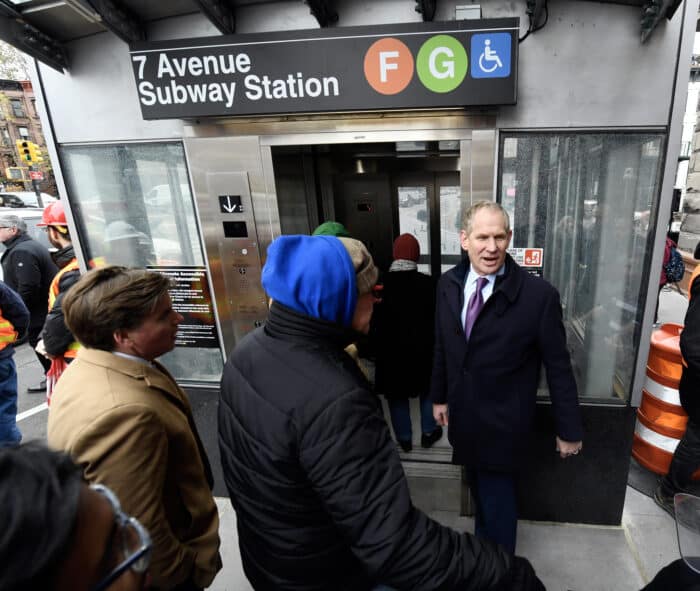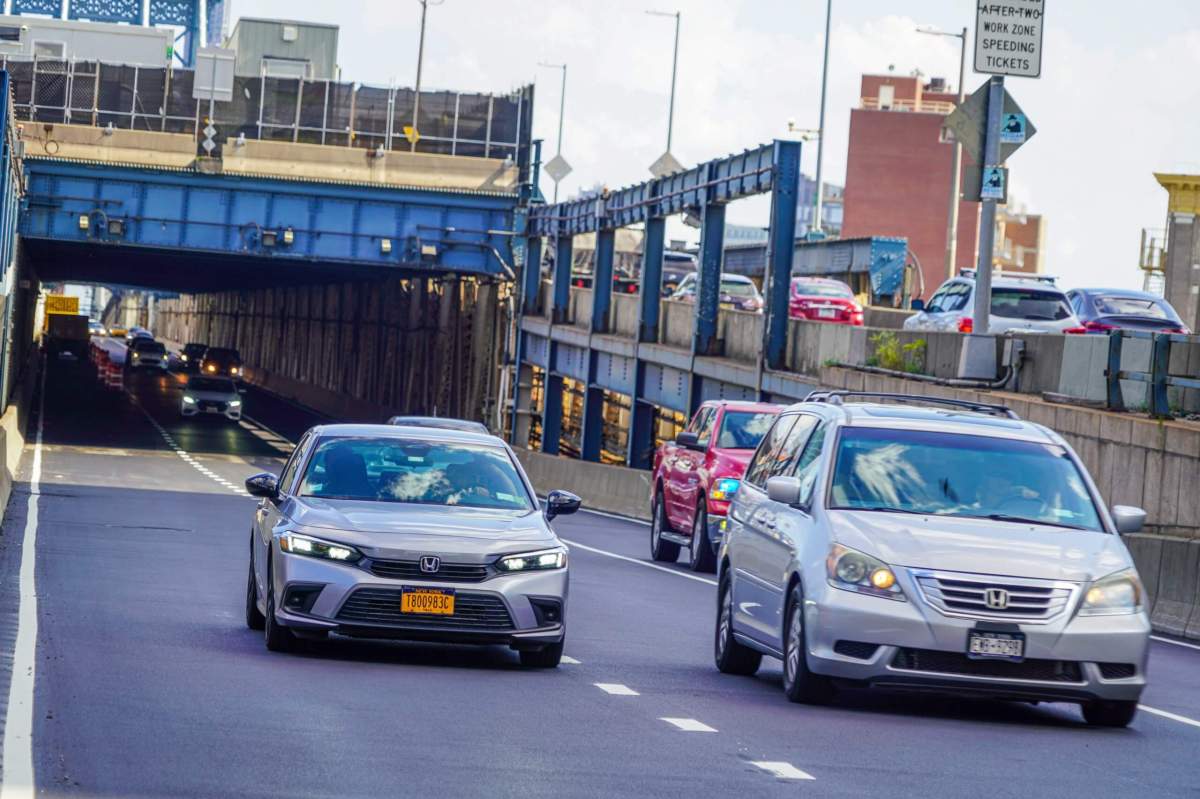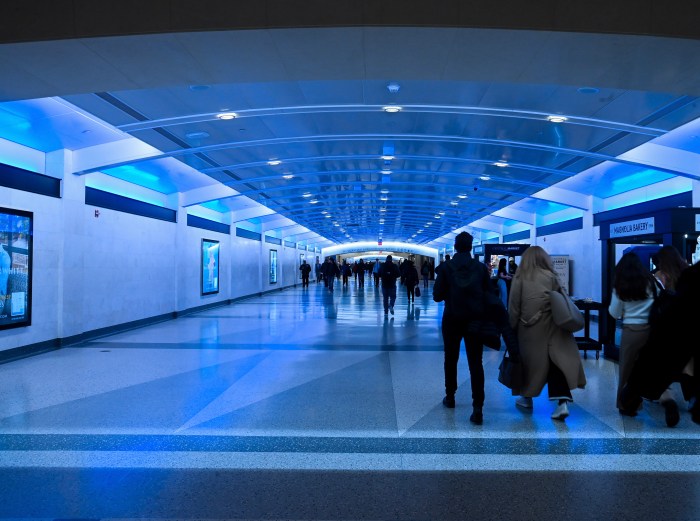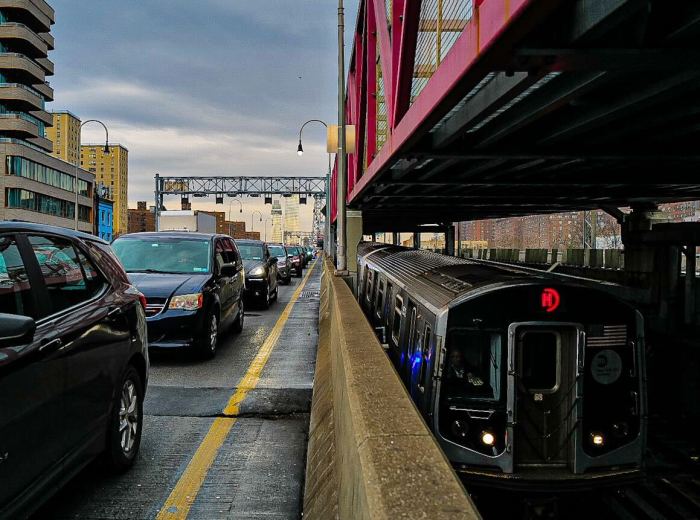The MTA Board has formally voted to recommend a $15 congestion pricing toll to enter Manhattan’s central business district, teeing up months of public input ahead of an anticipated debut in late spring 2024.
The Wednesday morning vote is not a final approval for the tolling scheme to drive into Manhattan south of 60th Street, but still represents one of the final hurdles the mammoth proposal had to clear before it could be implemented. The board’s members voted 9-to-1 to approve the Traffic Mobility Review Board’s (TMRB) proposal, with Nassau County rep David Mack voting in the negative.
“It’s a big day, we’ve been talking about congestion pricing for decades,” said MTA Chair Janno Lieber after Wednesday’s board meeting. “We’re getting very close to the end of this journey or the beginning of the new journey, and it is very exciting.”
The proposal calls for a $15 toll once per day for most motor vehicles entering the Manhattan CBD, with a $24 rate for small trucks and $36 for larger ones. Motorists driving through already-tolled MTA and Port Authority tunnels are eligible for “crossing credits” of up to $5, while the charge is discounted by 75% during the overnight hours to encourage nighttime deliveries. Tolls rise to $22.50 for cars not using E-Z Pass.
Yellow taxicabs will not be subject to the toll, with a $1.25 surcharge instead being affixed to all fares crossing into or out of, or within, the CBD. For rideshare services like Uber and Lyft, the surcharge is $2.50. Low-income drivers are eligible for a half-off discount after their first 10 trips in a given month, while low-income residents of the CBD are eligible for state tax credits.
The MTA can also add a 25% upcharge to the toll rate on “Gridlock Alert Days,” which occur on select days during the United Nations General Assembly and the late-year holiday season.
Despite a huge number of requests, the TMRB granted very few exemptions and discounts. Only commuter and transit buses, emergency vehicles, specialized government vehicles like garbage trucks and snow plows, and paratransit vehicles get an exemption. School buses are not exempt, as they are typically run by private companies; MTA officials say they want to exempt school buses but need to study the issue more, as school buses are sometimes used for reasons other than pupil transport.
Wednesday’s approval kicks off the State Administrative Procedure Act (SAPA) process, with opportunities for the public to weigh in in comments or at hearings expected to take place in February or March. Aspects of the scheme could be changed as a result of public feedback, but even minor changes could have “knock-on effects” to the complex “Jenga puzzle” underlying the plan, Lieber contended.
After the 60-day SAPA process concludes, the MTA Board will take a final vote to approve the program before it can be implemented. In the meantime, the agency will conduct public outreach campaigns and continue installing tolling infrastructure, which will be tested to ensure gantries are properly calibrated.

Meanwhile, federal authorities will analyze any changes made to ensure they align with the MTA’s mammoth environmental assessment of the project, while the city’s Department of Transportation will undertake a broad study on the impacts congestion pricing will have on parking.
“We look at it as something, in an ideal world, you wouldn’t mess with too much,” said Lieber. “That being said, we are taking the public comment period very seriously.”
For up to a year after implementation, the MTA will be able to change rates by up to 10% if honchos determine such a move would mitigate unforeseen negative effects.
Congestion pricing is in effect in cities around the world like London, Singapore, Stockholm, and Milan, but New York will be the first city in the United States to attempt it. The program is intended to reduce punishing traffic in the central business district, reduce carbon emissions in the New York region, and raise billions of dollars for MTA infrastructure projects, like making the subway accessible for people with disabilities, modernizing signals, and ensuring the century-old subway remains in a state of good repair.
Transit officials and advocates have dreamt of implementing congestion pricing in New York for decades, and in 2019 the New York State Legislature enacted it into law.
“Congestion pricing means cleaner air, better transit and less gridlock on New York City’s streets and today’s vote by the MTA Board is a critical step forward,” Gov. Kathy Hochul said in a statement. “This initiative will make New York City a global leader in transportation policy, and I’m grateful for the work of the Traffic Mobility Review Board to bring us to this milestone.”
While Lieber said he is “elated” by Wednesday’s vote, the road ahead is not smooth sailing. TMRB member John Samuelsen, president of the Transport Workers Union, resigned from the board rather than sign onto its proposal; on Wednesday, Samuelsen told reporters that the final product was all “disincentive” via tolls, without any “incentive” to move to transit by providing better service.
Mayor Eric Adams, who appointed Samuelsen to the TMRB and has historically supported congestion pricing, has been publicly ambivalent on the TMRB proposal, calling it “the beginning of the conversation” and calling for full exemptions for yellow taxis and school buses.
But the most serious hurdle remains a federal lawsuit filed by New Jersey this summer, which accuses the Federal Highway Administration of failing to conduct a thorough environmental review. Gov. Phil Murphy and various Garden State electeds say the program will divert traffic and emissions to New Jersey as drivers “toll shop,” while hitting their pocketbooks hard.
The lawsuit has the potential to seriously delay implementation of congestion pricing, and by extension, keep the MTA from raising money, forcing delays to infrastructure projects the agency had hoped to pursue in short order. Already, the lawsuit has forced the MTA to delay its project to modernize train signals on the A and C lines in Brooklyn, even as work is already underway on the line’s Manhattan segment.
“It’s hard to award a contract when you don’t have a certain revenue source,” said Lieber. “So there are potential impacts.”
Like the rest of the region, the majority of New Jersey commuters arrive in Manhattan on transit. At a rally in support of congestion pricing on Tuesday, Lieber mocked New Jersey officials adamantly opposed to the scheme, noting high tolls to drive on the New Jersey Turnpike. Without naming names, he appeared to take aim at New Jersey Rep. Josh Gottheimer, a fierce congestion pricing foe; he knocked the lawmaker for his position as co-chair of the “Problem Solvers Caucus” even as transit investments languish in his home district and state.
“It’s a simple problem, it’s called inertia addiction,” said Lieber. “These are self-styled problem-solvers who have actually never lifted a finger for mass transit, even when there is a half-finished rail line in their own goddamn district. We in New York deal with our problems.”


































